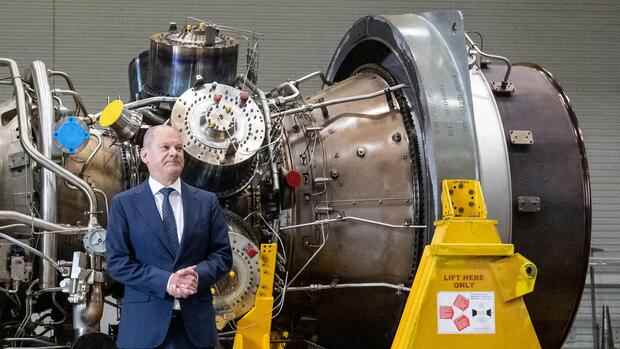The Federal Chancellor inspects the gas turbines at Siemens Energy in the Ruhr area.
(Photo: dpa)
Mülheim an der Ruhr Germany has been puzzling over the status and whereabouts of the SGT-A65 gas turbine for weeks. Because, according to Russia, the restoration of the gas supply via the Nord Stream 1 pipeline depends on it. On Wednesday, Chancellor Olaf Scholz (SPD) visited the plant in Mülheim an der Ruhr. After its maintenance in Canada, it has been there for almost two weeks in a warehouse of the German technology specialist Siemens Energy.
Scholz calls the turbine an “impressive piece of technology”. He can’t help but smile. But there is nothing “mystical” to consider here: “The turbine is there and can be delivered. Someone just has to say: I want her, then she’ll be there very quickly,” emphasizes the SPD politician. And that is precisely the reason for the chancellor’s spontaneous visit to the Ruhr area. It is a demonstration and a clear signal to Russia.
In mid-June, the Russian gas company Gazprom cut deliveries via Nord Stream 1 to 40 percent. In the meantime, only 20 percent come through the connection between Russia and Germany.
“Technical defects” are to blame, Gazprom has been making excuses for weeks. The problem is rather the Germans and their company Siemens Energy. This is also the view taken by Russian President Vladimir Putin. In the run-up to his visit, Scholz had described this as “Putin’s bluff”, which has now been exposed as such.
Top jobs of the day
Find the best jobs now and
be notified by email.
Siemens Energy CEO Christian Bruch also disagrees. There are no technical reasons why only 20 percent of natural gas from Russia is currently arriving via the Baltic Sea pipeline. “There are six such turbines in the compressor station in Portovaya, Russia, plus two smaller ones. It takes five for full power. Only one of them is currently running. From a technical point of view, we cannot understand that,” Bruch criticized sharply in the direction of Russia. The company also has no technical defects in other turbines.
Schröder criticizes and calls for Nord Stream 2
Former Chancellor Gerhard Schröder, who until recently was a member of the supervisory board of the Russian energy company Rosneft, also got involved in the debate. In an interview with the media of the RTL group, Putin’s confidante blamed Siemens Energy for the delays. He doesn’t know why the turbine is in Mülheim and not in Russia. He also called for the Nord Stream 2 pipeline, which was controversial and recently stopped by the Chancellor as part of the sanctions against Russia, to be put into operation.
When asked about the statements, Scholz avoided direct criticism of his party colleague. He only made one thing very clear: “We ended the approval process for Nord Stream 2 for good reasons. There is sufficient capacity at Nord Stream 1 and no shortage of opportunities for Russia to fill its contracts through it or through the Ukraine pipeline.”
The turbine epic, under which Scholz and Siemens now want to draw a line, began with the routine maintenance of the device in Canada. From there it could not be taken directly back to Russia due to Canadian sanctions as a result of the war of aggression against Ukraine. However, their use in the pipeline was not planned until September anyway.
>> Read also: Siemens’ counterattack on Gazprom’s turbine saga was overdue
“What is missing are the necessary customs documents for importing into Russia,” said Siemens Energy previously. Again, this information could only be provided by Gazprom. Siemens Energy is clear: “The transport of the turbine has been prepared and could start immediately.”
The Nord Stream 1 pipeline, which is 1,224 kilometers long, is regularly serviced. They are part of the routine and are planned in advance. Niko Bosnjak from the network operator Open Grid Europe (OGE) explains: “Even if a turbine should fail, we always work with such stations with redundancies, so there are always several of these turbines, so that we are able to compensate for failures.”
More: New calculations: The gas will probably be enough “this winter and next”

